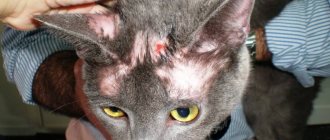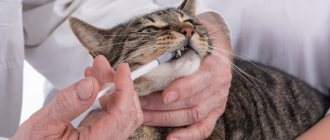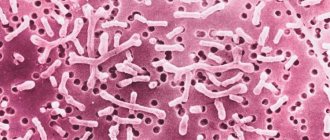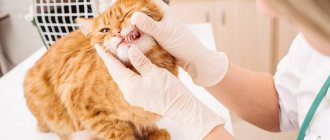Ascites is dropsy of the abdominal cavity in cats. The idea that this is a separate disease is erroneous. Ascites develops against the background of a chronic pathology that has developed in the body, and is characterized by the accumulation of fluid in the abdominal cavity, which exceeds normal levels.
Excess intrauterine fluid puts pressure on the internal organs, making it difficult for them to function. The process is dangerous because dangerous complications, including death, will arise in the pet’s body.
Why does ascites develop?
Absolutely any animal can suffer from ascites, but cats that lead a sedentary lifestyle are most susceptible to this pathological condition. A small volume of serous fluid is always present in the abdominal cavity, ensuring satisfactory functioning of the internal organs.
Indicators exceeding the norm pose a danger to the body.
Excessive accumulation of fluid in the abdominal cavity is provoked by the following factors:
- cardiovascular pathologies;
- renal failure;
- liver diseases;
- decreased albumin levels;
- hepatitis;
- diabetes;
- tuberculosis;
- peritonitis;
- infections, parasites, fungi;
- weak immunity;
- overweight;
- hormonal imbalances;
- oncology;
- abdominal injuries that provoked an inflammatory process in the abdominal cavity;
- bladder rupture;
- nephrotic syndrome;
- excess salt in the diet, economy class food and, as a result, an increase in sodium concentration;
- violation of water-salt and protein metabolism.
This is not a complete list of the reasons leading to abdominal dropsy in cats.
The mechanism of transudate formation in various pathologies
When the liver is damaged by various toxic agents, hepatitis or cirrhosis of the liver develops, which leads to stagnation of blood in the portal vein and increased effusion of transudate into the abdominal cavity.
In heart failure, venous blood, due to its low velocity, accumulates in the veins of the abdominal cavity, which complicates its outflow and leads to the effusion of blood filtrate into the peritoneal cavity.
Kidney pathology leads to fluid retention and accumulation in the peritoneum.
Normally, a small amount of serous fluid should be in the abdominal cavity. It supports the normal functioning of internal organs. But if the liquid begins to accumulate in a large volume, then this becomes dangerous for the normal functioning of the animal’s body.
Clinical picture
The initial stage of the pathological condition is virtually asymptomatic, since the accumulation of fluid in the abdominal cavity is a gradual process. Characteristic signs can only be noticed when the volume of fluid exceeds normal levels. Ascites can be suspected by a noticeably swollen abdomen and stretching of the sides when the animal is active.
Symptoms:
- the abdominal cavity is swollen, hard to the touch;
- fluctuation - when pressing on the abdomen, you can feel the liquid inside it swaying;
- the belly takes on the shape of a pear when the cat stands on its hind legs, and inflates and rounds when taking a sitting position;
- dullness and disheveled fur;
- yellowish tint of mucous membranes;
- paws, ears, crotch, sternum swell;
- vomiting, nausea;
- lack of appetite;
- constipation or diarrhea;
- breathing problems, hoarseness, shortness of breath;
- weakness, apathy.
It is very important to distinguish ascites from ordinary overeating.
Symptoms of ascites
Intra-abdominal fluid in a cat accumulates gradually over some time. The manifestation of external signs occurs with the development of changes in the internal organs. Signs of ascites are:
- the cat's unnaturally large belly;
- tousled, dull coat;
- difficulty breathing, shortness of breath;
- decreased motor activity, the cat lies most of the time;
- yellow tint of the gum mucosa;
- rapid heartbeat;
- refusal of food, rapid exhaustion.
INTERESTING TO KNOW: If there is blood in a cat’s urine, take immediate action
Ascites in a cat can be determined by its moving abdomen. It shifts when the animal’s body position changes. When palpating the abdomen, one feels the movement of fluid under the fingers. But in order to accurately determine the presence of fluid in the cat’s abdominal cavity, you need to contact a veterinarian. The true cause of ascites can be determined through a diagnostic examination of the animal.
Diagnostics in a veterinary clinic
The task of diagnosis is to differentiate otitis from other diseases with similar symptoms, for example, from exudative peritonitis. Thus, with peritonitis, an increase in temperature, pain when pressing on the abdomen, and a significant number of leukocytes and proteins in the exudate are observed.
And finally, the most obvious sign of peritonitis is the transience of the disease. With ascites, as mentioned above, the disease has a long development.
Necessary diagnostic methods for suspected ascites include:
- anamnesis;
- analysis of clinical symptoms;
- palpation of the abdominal cavity;
- urine and blood tests;
- X-ray of the peritoneum, sternum;
- Ultrasound of the chest and abdominal cavity;
- fluid examination;
- endoscopy;
- biopsy.
Differential diagnosis helps to identify the underlying pathology that caused ascites. Without determining the provoking factor, it is impossible to prescribe adequate treatment, since the amount of fluid will increase with each relapse.
Diagnosis of ascites
Examination of the cat reveals symmetrical bilateral enlargement of the lateral abdominal walls. If you stand the animal on its hind legs, the belly takes on a pear-shaped shape with a downward expansion.
The cat has difficulty breathing, shortness of breath, swelling in the perineum and lower extremities. When collecting anamnesis, attention is paid to existing chronic infectious and systemic diseases in the animal, the manifestation of symptoms, and their duration.
To confirm the diagnosis, a study of peritoneal fluid is performed. To do this, the veterinarian performs a puncture of the peritoneum to collect transudate for examination.
Laboratory tests of urine and blood, ultrasound and abdominal radiography are also prescribed.
Can ascites in cats be treated or not?
Treatment of ascites is carried out comprehensively. Therapy is aimed at eliminating the underlying disease, alleviating pain symptoms and strengthening the immune system.
To reduce the amount of fluid in the abdominal cavity, laxatives and diuretics are indicated (Furosemide, Temisal, decoction of bearberry leaves, liver and kidney teas).
To stabilize the functioning of the cardiovascular system, drugs such as Olitorizide, Strophanthin, Digitoxin, Cardiovalen are necessarily prescribed.
If there is an infection in the body, antibiotic therapy using drugs from a number of cephalosporins is indicated.
To strengthen the walls of blood vessels and reduce their permeability, the veterinarian prescribes intravenous solutions of calcium chloride (10%).
To pump out the fluid, a puncture is done when the veterinarian pierces the abdominal wall. The procedure is performed at least twice a week. In this case, the removal of ascitic fluid must be compensated by reinfusion of ascitic transudate or administration of an albumin solution. These procedures provide a chance for additional remission and prolongation of the animal’s life.
The course of treatment depends on the condition of the animal and the amount of fluid. This is a long process that must continue until the clinical signs of dropsy completely disappear.
As for the prognosis, with adequate and, most importantly, timely therapy, it is favorable. If you do not seek help from a specialist in time, the volume of fluid will increase to two liters per day or more. This pathological condition is fraught with pressure on internal organs and disruption of their functions.
Features of treatment
Abdominal hydrops in cats is not a disease, but a symptom of an underlying disease. Therefore, the main efforts are directed towards its treatment. The procedures are accompanied by transferring the animal to a new, special diet; food is prepared without salt; the main parameter for choosing food is its high protein content. The daily volume of water is reduced, and the availability of all “sources” of water in the apartment is limited.
To reduce swelling of the abdominal cavity, the pet is prescribed diuretics and laxatives if the process is accompanied by constipation. When drug treatment does not bring the desired result and excess fluid remains in the body, it is pumped out using a syringe. The procedure is carried out under anesthesia, after which the cat is given injections of anti-inflammatory drugs.
Depending on the changes detected, the cat is prescribed medications to normalize cardiac activity - cardiotonics, restore vascular elasticity, their permeability, anti-inflammatory drugs. With the help of medications, the functioning of the kidneys and liver is corrected, and metabolic processes are restored.
What should the owner do
Under no circumstances should you play Aibolit or give your pet medications without consulting a veterinarian. Only a specialist can prescribe medications and set their dosage, based on the severity of the pathology, general condition and age of the animal.
Uncontrolled use of medications can lead to potassium being excreted from the body along with urine. This will worsen the cat’s well-being and lead to complications, even to the point where the animal dies. Human diuretics are especially dangerous in this regard.
Increasing their dosage independently can lead to disturbances in the level of electrolytes and leaching of fluid from the microcirculation network. This is fraught with the possible development of encephalopathy.
If the owner does not have the opportunity to immediately take his four-legged pet to a veterinary clinic after identifying dangerous signs, this can alleviate his condition with the help of birch decoction. To do this, dry birch leaves are brewed with boiling water in a ratio of 1:10, leave for at least 5 hours. Give your cat the prepared infusion twice a day.
However, you need to understand that this folk remedy can only alleviate symptoms, but it cannot replace full-fledged drug treatment.
As soon as possible, you should take the animal to the clinic so that the doctor can examine it and prescribe appropriate treatment.
A cat with abdominal hydrops is prescribed a therapeutic diet that involves limiting the consumption of water and any other liquid. The food of a sick pet should be nutritious, balanced in vitamins, minerals and carbohydrates and consist mainly of proteins.
The diet includes meat, poultry, sea fish, cottage cheese, and kefir. You can add salt to your food, but the amount should be minimal.
Diagnostic methods
Since the causes of ascites in cats are numerous pathologies of organs and systems, treatment of the underlying disease is required to get rid of its main symptoms. To begin the “correct” procedures, a high-quality diagnosis of the functions of the animal’s body is required.
At the initial visit to the veterinary clinic, specialists examine the animal, during which they assess its general condition and identify characteristic changes. The owner of the cat is obliged to inform the doctor about his chronic diseases and their exacerbations.
To confirm the main diagnosis, the cat is prescribed and carried out:
- clinical tests of urine (the protein content in it is assessed), blood (general, biochemical);
- body temperature is monitored;
- the animal's electrocardiogram is taken and analyzed;
- X-ray of the thoracic region, peritoneum;
- examination of fluid from edematous tissue;
- endoscopic examination of the stomach;
- Ultrasound examination of the abdominal organs.
© shutterstock
If an animal develops a tumor process, a biopsy of the altered tissue is performed.
Only after the cause of the development of abdominal dropsy in cats has been reliably determined, subsequent therapy, its features and expected effectiveness are discussed with the owner of the animal, and then the pet begins to be treated.
The cat has jaundice and ascites. Is it possible to do IVs?
Hello. Cat, 3 years old. Outbred. Spayed two years ago. Grafted with a quadricate. Food - Royal Canin for cats prone to constipation (according to indications). The medical history is long. All prescriptions were made by a veterinarian; no self-medication was done. Initially, they began to treat traumatic keratitis. After retrobulbar novocaine blockades, the temperature rose sharply to 41 degrees. They urgently knocked it down with a lytic mixture. After the blockade was lifted, the temperature returned to normal. Now it's 37.5. And so on for three days. But signs of hepatitis appeared. After the lytic mixture, my appetite disappeared immediately, but the alarm was sounded two days later, when the bases of my ears turned pale yellow. Showed it to the vet. Prescribed Essentiale and Mezim 1/2 tablet orally 2 times a day, Gamavit 1 ml s.c. 2 times a day, Liarsin s.c. 1 time a day, glucose orally 5-6 times a day 20 ml. After two days of treatment, ascites appeared. There are no improvements. She was fed baby food through a syringe and drinks on her own. No vomiting. Urine is yellow-brown in color (before starting to use glucose it was bright yellow), he goes to the toilet 2-3 times a day. She hasn't walked much since she stopped eating on her own. This evening, that is, two days after the start of treatment and four days after using the mixture, signs of ascites appeared: the abdomen is slightly enlarged, although outwardly it is almost not noticeable. We consulted with a doctor by phone. Starting tomorrow I prescribed Essentiale, Gamavit, glucose and furosemide through droppers. He told me to now take a furosemide tablet and give me a subcutaneous drip with glucose. Furosemide gave me 1/2 tablet (it’s scary), I’m afraid to do an IV because of dropsy. Question: is it possible to give IVs for dropsy?! What's the prognosis? We live in a small provincial town. There is no way to do a simple urine or blood test. All appointments were made after a purely visual examination. I don’t have the opportunity to take it anywhere else. I kindly ask you not to lecture me about the toxicity of analgin :( I understand everything, but the temperature was constantly rising, the condition worsened, and after almost a week we decided to bring down the temperature. There were no other options other than a lytic mixture. I really hope for an answer.
Prevention
The best treatment for any disease is its prevention. Cats, like people, need to follow a diet. There is no need to stuff your pet with all kinds of products that contain unnatural additives. The animal’s body is very sensitive to such “chemistry” and may not be able to cope with the load on the internal organs.
It has been proven that ascites is much more common in animals that do not have the opportunity to often walk in the fresh air. No matter the size of the apartment or house, the cat needs to move in its natural habitat. These animals have a very developed instinct of self-preservation, and, having felt the first signs of malaise, they can find the necessary grass themselves and cleanse their stomach.
Periodic visits to a veterinary clinic will also help identify the disease at an early stage and begin treatment on time. It is definitely worth choosing a suitable complex of vitamins necessary for the harmonious development of your pet.
How long a cat lives with ascites depends, first of all, on the stage of the disease and on the caring owner.
Treatment at home
Self-medicating ascites at home is risky and very dangerous: even herbs that are brewed for a cat to alleviate its condition can harm it in the wrong proportion. What can we say about pharmaceutical drugs! The same furosemide that is given to sick cats has claimed many lives - not just cats. Therefore, if there is the slightest opportunity to get an appointment with a qualified veterinarian, try to do so. The doctor will not only help save the life of your pet, but will also give advice on how and what to feed the animal, and tell you how to prevent ascites from happening again.
Treatment with soda
But there are situations when it is not possible to get to the clinic, and the pet is getting worse. For this case, there are traditional medicine recipes.
A cat may find this folk remedy for ascites useful:
- dry birch leaves are taken and brewed in boiling water from a ratio of one to ten. Next, add two grams of soda per glass of water. The decoction is infused for six hours. The cat should be given it twice a day: morning and evening.
This remedy helps eliminate or alleviate the symptoms of ascites, but not the underlying disease that it could cause. Therefore, visit a veterinarian as soon as possible.











